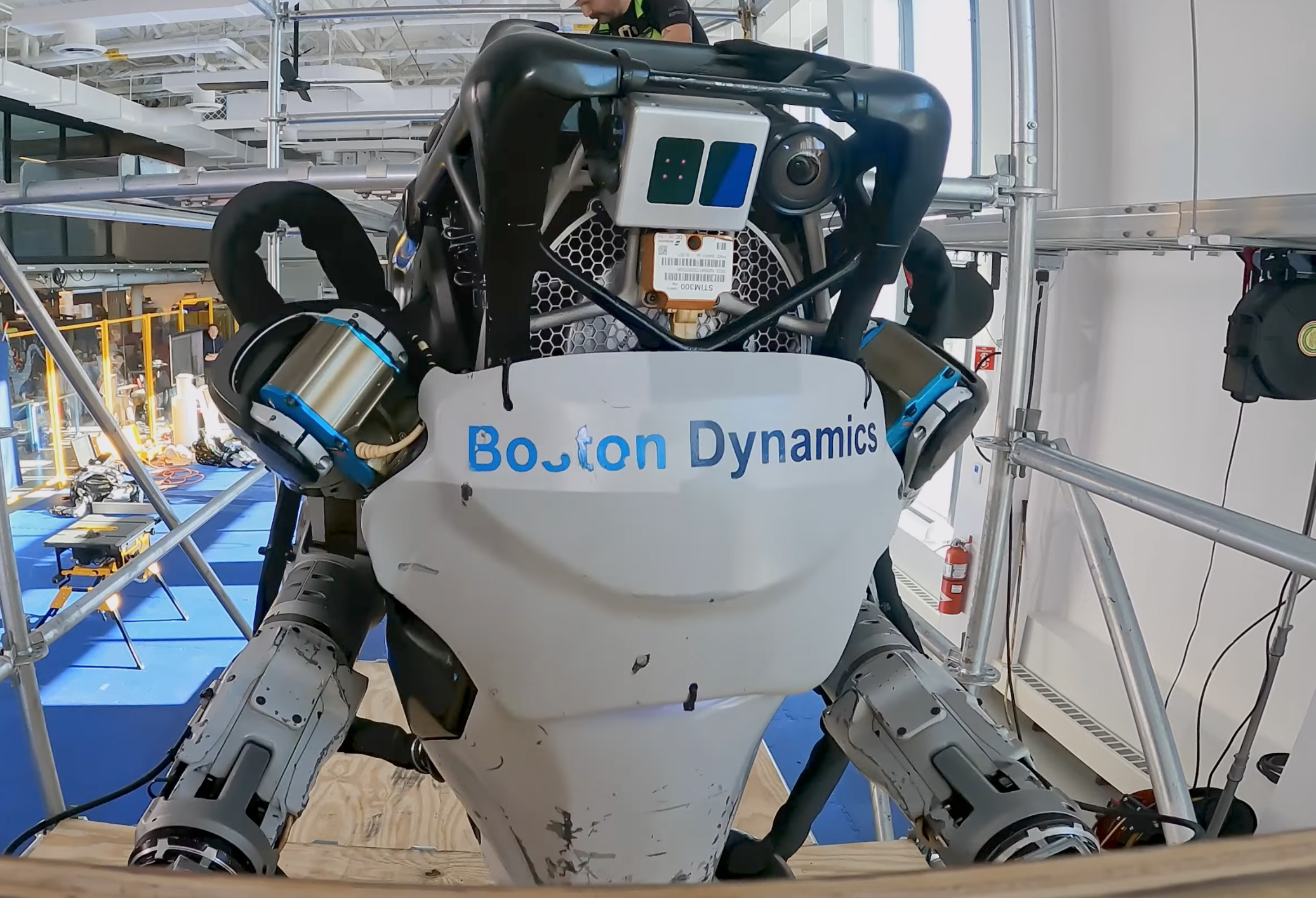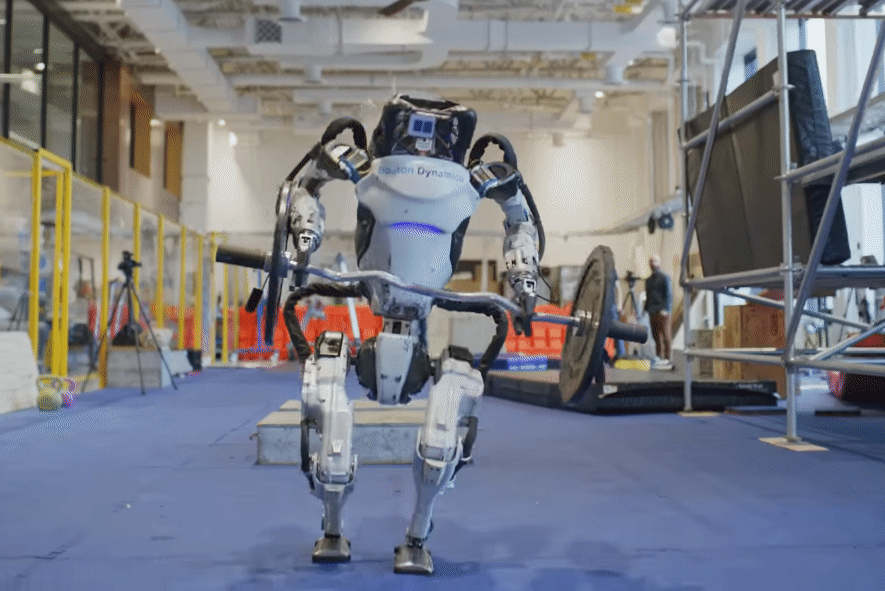 "Give 'em the clamps!" Atlas now has a pair of gripper claws. It also may be time for a new torso cover.Boston Dynamics
"Give 'em the clamps!" Atlas now has a pair of gripper claws. It also may be time for a new torso cover.Boston Dynamics Previous Atlas hands have been flat pads or balls, both of which can only pick up objects with pressure.
Previous Atlas hands have been flat pads or balls, both of which can only pick up objects with pressure. The claw, up close. Only the top "thumb" moves in this picture. Also look at the damage it's doing to that board. It's not gentle.
The claw, up close. Only the top "thumb" moves in this picture. Also look at the damage it's doing to that board. It's not gentle. Lift with your legs!
Lift with your legs!
Boston Dynamics' Atlas—the world's most advanced humanoid robot—is learning some new tricks. The company has finally given Atlas some proper hands, and in Boston Dynamics' latest YouTube video, Atlas is attempting to do some actual work. It also released another behind-the-scenes video showing some of the work that goes into Atlas. And when things don't go right, we see some spectacular slams the robot takes in its efforts to advance humanoid robotics.
As a humanoid robot, Atlas has mostly been focused on locomotion, starting with walking in a lab, then walking on every kind of unstable terrain imaginable, then doing some sick parkour tricks. Locomotion is all about the legs, though, and the upper half seemed mostly like an afterthought, with the arms only used to swing around for balance. Atlas previously didn't even have hands—the last time we saw it, there were only two incomplete-looking ball grippers at the end of its arms.
This newest iteration of the robot has actual grippers. They're simple clamp-style hands with a wrist and a single moving finger, but that's good enough for picking things up. The goal of this video is moving "inertially significant" objects—not just picking up light boxes, but objects that are so heavy they can throw Atlas off-balance. This includes things like a big plank, a bag full of tools, and a barbell with two 10-pound weights. Atlas is learning all about those "equal and opposite forces" in the world.
Like everything in robotics, picking up and carrying an object is more complicated than it seems. Atlas has to figure out where it is in the world in relation to the object it's picking up, come up with a grasping plan for the hands, and lift and manipulate the object, all while calculating how this extra bit of mass will affect its balance. As Boston Dynamics software engineer Robin Deits explains in the video, "When we're trying to manipulate something like a plank, we have to just make pretty educated guesses about where is the plank, how fast is it moving, how do we need to move the arms to cause the plank to spin 180 degrees very quickly, and if we get those estimates wrong we end up doing silly things and falling over."
Atlas isn't just clumsily picking things up and carrying them, though. It's running, jumping, and spinning while carrying heavy objects. At one point it jumps and throws the heavy toolbox up to its construction partner, all without losing balance. It's doing all this on rickety scaffolding and improvised plank walkways, too, so the ground is constantly moving under Atlas' feet with every step. Picking up stuff is the start of teaching the robot to do actual work, and it looks right at home on a rough-and-tumble construction site. The simple claw grippers mean Atlas crushes everything it picks up, though, with objects like the plank showing visible damage where the hands dug into it. Maybe the next set of experiments will teach Atlas to be less of a hulking gorilla.
 Atlas sees the world through two main sensors, a color camera (the round lens) and what looks to be a Lidar sensor (the square gray box). The orange box is a bunch of accelerometers.
Atlas sees the world through two main sensors, a color camera (the round lens) and what looks to be a Lidar sensor (the square gray box). The orange box is a bunch of accelerometers. Here's a real look at Atlas' vision: a colored point cloud.
Here's a real look at Atlas' vision: a colored point cloud. The clump of yellow dots is the tool bag from the video. Atlas is coming up with a gripping plan.
The clump of yellow dots is the tool bag from the video. Atlas is coming up with a gripping plan. A chair lift in the simulator.
A chair lift in the simulator. Programming a Zoidberg dance. I assume the lines at the bottom are for each joint.
Programming a Zoidberg dance. I assume the lines at the bottom are for each joint.
In a behind-the-scenes video, Boston Dynamics also detailed how Atlas sees and some of the software that makes the machine work. There is a whole simulator for the robot where they can choreograph moves and attempt things without smashing a real-world robot. The always-shifting, unstable nature of the real world means Atlas has to autonomously make a million tiny movement decisions just to stay upright, but the macro actions in these Atlas videos are all planned movements. The simulator lets Boston Dynamics program in all sorts of tricks, like the big finish for this video: a two-axis flip.
Atlas sees with only two sensors: a color camera and a Lidar module, and the output is a colored point cloud. That's enough to move around but nothing like the production robots Stretch and Spot, which both have a ton of cameras for safety, object recognition, and navigation. Vision is another possible area of improvement for Atlas. The Boston Dynamics blog said that some videos, like the dance routine, were done "entirely blind," while this is focusing more on Atlas being able to see and understand the world.
Boston Dynamics has always strived to build robots meant for the real world, and that means installing them with an amount of toughness you usually don't see in other robotics projects, whether that's filming a YouTube video with obviously smashed-up exterior panels and scratched paint or just running around without a harness or any kind of safety gear. Part of that toughness culture is not being afraid to show when things go wrong, so we'll leave you with a compilation of gnarly robot slams from the latest video.
 Balance... balance... nope I give up.
Balance... balance... nope I give up. Doing a backflip? Hard. Doing a backflip while holding a barbell? Even harder.
Doing a backflip? Hard. Doing a backflip while holding a barbell? Even harder. Can Atlas feel pain? Sometimes I'm not quite sure.
Can Atlas feel pain? Sometimes I'm not quite sure.
Listing image by Boston Dynamics
https://news.google.com/__i/rss/rd/articles/CBMidGh0dHBzOi8vYXJzdGVjaG5pY2EuY29tL2dhZGdldHMvMjAyMy8wMS9ib3N0b24tZHluYW1pY3MtYXRsYXMtcm9ib3QtZ3Jvd3MtYS1zZXQtb2YtaGFuZHMtYXR0ZW1wdHMtY29uc3RydWN0aW9uLXdvcmsv0gF4aHR0cHM6Ly9hcnN0ZWNobmljYS5jb20vZ2FkZ2V0cy8yMDIzLzAxL2Jvc3Rvbi1keW5hbWljcy1hdGxhcy1yb2JvdC1ncm93cy1hLXNldC1vZi1oYW5kcy1hdHRlbXB0cy1jb25zdHJ1Y3Rpb24td29yay9hbXAv?oc=5
2023-01-19 21:24:17Z
1745115371
Tidak ada komentar:
Posting Komentar